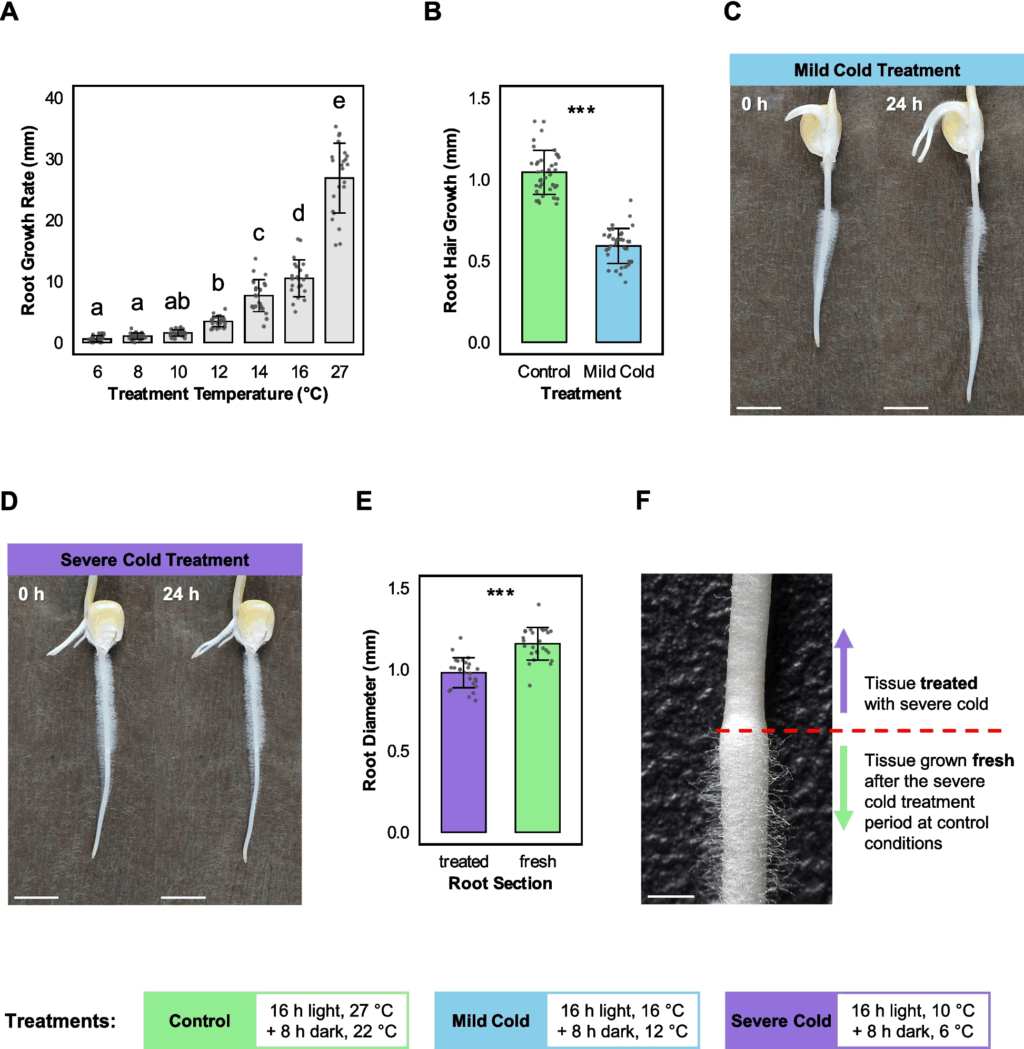
Domesticated in Central America around 10,000 years ago, maize has become a cornerstone of global agriculture. Providing essential resources for food, feed, and industrial applications, maize is cultivated across diverse climates, from tropical to temperate regions. However, its adaptability is challenged by cold stress, especially in temperate areas like Central and Northern Europe. This stress, exacerbated by climate change, threatens early growth phases, impacting yield and plant vigor.
Cold stress, defined by temperatures below the optimal growth range of 21 °C to 27 °C, can delay seedling emergence, reduce germination rates, and compromise plant vigor. The increasing frequency of extreme weather events due to climate change further underscores the need for robust cold tolerance in maize.
Impact of Cold Stress on Maize Root Development
Cold temperatures reduce the hydraulic conductance of roots, negatively affecting water relations and nutrient uptake. This restriction in growth potential prompts plant cells to increase the production of compatible solutes, such as carbohydrates and specific amino acids, to maintain cellular water potential and protect against dehydration. In maize, epidermal cells, particularly root hairs, are highly sensitive to cold, showing significant gene expression changes after exposure.
Root hairs, as tubular outgrowths of epidermal cells, increase the root’s surface area, enhancing nutrient and water uptake while supporting plant anchorage. They play a crucial role in the adaptation and resilience of roots under cold conditions.
Transcriptomic and Morphological Responses
The molecular and physiological responses of maize to cold stress involve a dynamic interplay of metabolic and gene expression changes aimed at maintaining homeostasis under suboptimal conditions. Cold stress significantly affects gene expression, activating pathways associated with transcription, stress signaling, and cell-wall organization. Transcriptional changes regulated by the INDUCER OF CBF EXPRESSION (ICE) signaling cascade orchestrate a comprehensive cold response, with key transcription factors like C-REPEAT BINDING FACTOR/DRE BINDING FACTOR1 (CBF/DREB1) and DREB2 playing pivotal roles.
Reactive oxygen species (ROS) accumulation is a common response to cold stress, potentially damaging lipids, proteins, carbohydrates, and DNA. However, at optimal levels, ROS act as signaling molecules, promoting root hair elongation. Excessive ROS accumulation inhibits growth by causing oxidative damage.
Experimental Approach and Findings
To investigate how cold stress affects maize root hairs, researchers subjected seedlings of the maize inbred line B73 to mild and severe cold treatments. The study aimed to characterize the molecular pathways affected by varying cold intensities and determine how these pathways influence root hair development.
High-resolution photographs and microscopic images were taken to measure root and root hair lengths. RNA samples were collected for transcriptome analyses, revealing significant gene expression changes in response to cold stress.
Key Findings
The study found that cold stress inhibits primary root and root hair growth, with severe cold stress leading to a permanent arrest of cell extension in affected tissues. Transcriptomic analyses revealed that both mild and severe cold conditions trigger unique and shared sets of differentially expressed genes, with severe conditions eliciting a broader network of adaptive mechanisms.
“Approximately 49% of the genes downregulated under mild cold conditions were also downregulated under severe cold stress.”
Functional enrichment analyses highlighted significant pathways affected by cold stress, including the phenylpropanoid biosynthesis pathway, which was downregulated, suggesting a reduction in secondary metabolite production essential for lignin biosynthesis and cell wall formation.
Implications for Maize Cultivation
The findings underscore the importance of understanding cold stress responses to improve maize resilience. By identifying key transcription factors and pathways involved in cold response, breeders can develop maize varieties with enhanced cold tolerance, crucial for maintaining yields in temperate regions.
As climate change continues to alter weather patterns, the ability to cultivate maize in cooler climates without significant yield loss becomes increasingly vital. Future research should focus on exploring genetic variations among maize cultivars to identify traits that confer enhanced cold tolerance.
Overall, this study provides valuable insights into the molecular basis of cold tolerance in maize, offering potential pathways for developing more resilient crop varieties in the face of climate change.






